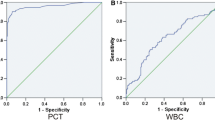Abstract
Intestinal obstruction is responsible for 3% of admissions to hospital emergency surgical departments, but it is difficult to distinguish simple obstruction from strangulation. Simple criteria for this distinction are sought. In this experimental study, procalcitonin, a known marker of bacterial inflammation, was used to detect strangulation. The predictive value of procalcitonin for small bowel strangulation was evaluated. Thirty male New Zealand rabbits (mean weight: 3.0 kg) were divided into three groups. In the first (control) group, only laparatomy was performed. In the second group, simple obstruction was created by ligating a 10-cm distal ileum segment. In the third group, distal strangulation was created by ligating a 10-cm distal ileum segment with the mesentery. Blood (1 cc) was taken from the right auricular vein of each animal for measuring the procalcitonin level. In both the control group and the simple obstruction group the procalcitonin levels were normal. In the strangulation group, elevation of procalcitonin was detected after 30 minutes, and the elevation was statistically significant at 120th minute compared with the control and simple obstruction groups. In patients with small bowel obstruction, measurement of procalcitonin levels is easy to perform and can be used in the follow-up. A more extensive clinical study is needed to evaluate the accuracy of the test as a marker.

Similar content being viewed by others
References
G Miller J Boman I Shrier et al. (2000) ArticleTitleNatural history of patients with adhesive small bowel obstruction Br. J. Surg. 87 1240–1247
P Mucha (1987) ArticleTitleSmall intestinal obstruction Surg. Clin. North Am. 67 597–621
WG Chadle EE Garr JD Richardson (1988) ArticleTitleThe importance of small bowel obstruction Am. Surg. 54 565–569
D Menzies H Ellis (1990) ArticleTitleIntestinal obstruction from adhesions-how big is the problem? Ann. R. Coll. Surg. Engl. 72 60–63 Occurrence Handle1:STN:280:By%2BC2cngsVc%3D Occurrence Handle2301905
WO Richards LF Williams (1988) ArticleTitleObstruction of the large and small intestine Surg. Clin. North Am. 68 358–376
MG Sarr GD Bulkly GD Zuidema (1983) ArticleTitlePreoperative recognition of intestinal strangulation obstruction Am. J. Surg. 145 176–182
BF Helmkamp J Kimmel (1985) ArticleTitleConservative management of small bowel obstruction Am. J. Obstet. Gynecol. 152 677–679
PG Horgan TF Gorey et al. (1992) ArticleTitleOperative assessment of intestinal viability Surg. Clin. North Am. 72 143–155
LD May MM Beronson (1993) ArticleTitleValue of serum inorganic phosphate in the diagnosis of ischemic bowel disease Am. J. Surg. 146 266–268
S Acosta TK Nilson M Bjorck (2001) ArticleTitlePreliminary study of D-dimer as a possible marker of acute bowel ischaemia Br. J. Surg. 88 385–388
O Makita I Ikushirna N Matsurnoto et al. (1999) ArticleTitleCT differentiation between necrotic and nonnecrotic small bowel in closed loop and strangulating obstruction Abdom. Imaging 24 120–124
D Frager S Medwid J Baer et al. (1994) ArticleTitleCT of small bowel obstruction: value in establishing the diagnosis and determining the degree and cause Am. J. Roentgenol. 162 37–41
E Geuses I Vervloessem D Vanbeckevoort et al. (2001) ArticleTitleUltrasonography in the evaluation of acute abdomen: intestinal pathology Emerg. Radiol. 8 134–143
JJ Peck T Milleson J Phelan (1999) ArticleTitleThe role of computed tomography with contrast and small bowel follow-through in management of small bowel obstruction Am. J. Surg. 177 375–378
Y Ko J Lim D Lee et al. (1993) ArticleTitleSmall bowel obstruction: sonographic evaluation Radiology 188 649–653
CA Arciero GN Bender CD Shriver (2001) ArticleTitleUtility of computed tomographic enteroclysis for the general surgeon Curr. Surg. 58 205–208
CK Chou CW Mak MC Huang et al. (2000) ArticleTitleDifferentiation of obstructive from non-obstructive bowel dilatation on CT Eur. J. Radiol. 35 213–220
HK Ha SU Rha JH Kim et al. (2000) ArticleTitleCT diagnosis of strangulation in patients with small bowel obstruction: current status and future directions Emerg. Radiol. 7 47–55
O Makita I Ikushima N Matsumoto et al. (1999) ArticleTitleCT differentiation between necrotic and nonnecrotic small bowel in closed loop and strangulating obstruction Abdom. Imaging 24 120–124
M Meisner (2002) ArticleTitlePathobiochemistry and clinical use of procalcitonin Clin. Chim. Acta 323 17–29
L Thomas (1998) Clinical Laboratory Diagnostics: Use and Assessment of Clinical Results EditionNumber1 TH Books-Verl-Gez Frankfurt/Main 710–714
ED Carrol APJ Thomson CA Hart (2002) ArticleTitleProcalcitonin as a marker of sepsis Int. J. Antimicrob. Agents 20 1–9
ES Nylen KT Whang RH Snider et al. (1998) ArticleTitleMortality is increased by procalcitonin and decreased by an antiserum reactive to procalcitonin in experimental sepsis Crit. Care Med. 26 1001–1006
B Rau G Steinbach K Baumgart et al. (2000) ArticleTitleThe clinical value of procalcitonin in the prediction of infected necrosis in the acute pancreatitis Intens. Care Med. 26 159–164
HB Reith U Mittelkotter ES Debus et al. (1998) ArticleTitleProcalcitonin in early detection of post operative complications Dig. Surg. 15 260–265
M Meisner K Tschailowsky A Hutzler et al. (1998) ArticleTitlePostoperative plasma concentrations of procalcitonin after different types of surgery Intens. Care Med. 24 680–684
G Monneret JM Labaune C Isaac et al. (1997) ArticleTitleProcalcitonin and C-reactive protein levels in neonetal infections Acta Pediatr. 86 209–212
C Chiesa C Pacifico G Macuso et al. (1998) ArticleTitleProcalcitonin in pediatrics: overview and challenge Infection 26 236–241
MD Smith Y Suputtamongkol W Chaowagul et al. (1995) ArticleTitleElevated serum procalcitonin levels in patients with melioidosis Clin. Infect. Dis. 20 641–645
D Cooper L Sharpless J Cornelisson et al. (2001) ArticleTitleComparison between procalcitonin, serum amyloid-A and C-reactive protein as markers of serious bacterial and fungal infections after solid organ transplantation Transplant. Proc. 33 1806–1810
Author information
Authors and Affiliations
Corresponding author
Rights and permissions
About this article
Cite this article
Ayten, R., Dogru, O., Camci, C. et al. Predictive Value of Procalcitonin for the Diagnosis of Bowel Strangulation. World J. Surg. 29, 187–189 (2005). https://doi.org/10.1007/s00268-004-7488-z
Published:
Issue Date:
DOI: https://doi.org/10.1007/s00268-004-7488-z




